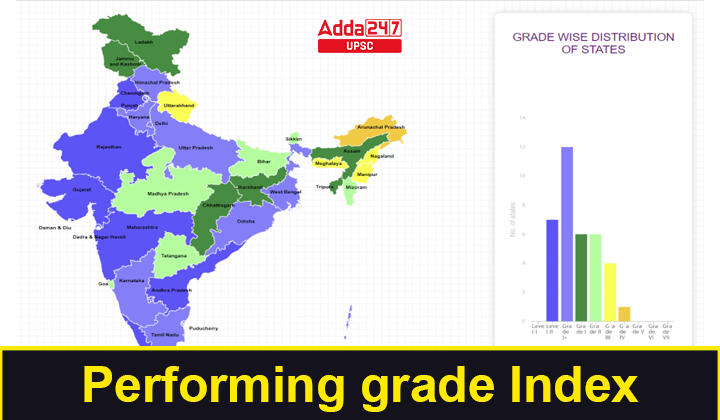Table of Contents
Performance Grading Index (PGI)
The PGI assigns marks to the states and UTs based on ten different categories. The PGI structure comprises of 1000 points across 70 indicators grouped into 2 categories viz., Outcomes, Governance Management (GM).
These categories are further divided into 5 domains:
- Learning Outcomes (LO)
- Access (A)
- Infrastructure& Facilities (IF)
- Equity (E)
- Governance Process (GP)
Released by: Department of School Education and Literacy (DoSE&L), Ministry of Education, was the one who came up with the idea.
Objective: To encourage the development of evidence-based policy and to bring attention to the need for course correction in order to guarantee that all students receive an education of a good enough quality.
The source of the data: The information for PGI 2020-21 comes from a number of places, including:
- Unified District Information System for Education Plus (UDISE +) 2020-21.
- National Achievement Survey (NAS) 2017 MDM Portal.
- Information from the MIS coordinators in each State/UT.
Performance Grading Index (PGI) UPSC Relevancy
For Prelims: Current events of national and international importance.
For Mains: GS-Paper II- Issues relating to the development and management of Social Sector/Services relating to Health, Education, and Human Resources.
Performance Grading Index (PGI) Why in News?
The report on the Performance Grading Index 2.0 for States/UTs for the year 2021-22 was been released recently by the Ministry of Education. The report uses a standard scoring system to evaluate the performance of the states and UTs.
New Framework
The new framework of the PGI encompasses 70 indicators and places a greater emphasis on qualitative evaluation, which takes into account digital efforts as well as teacher education. Therefore, the grades and levels that were earned by states and UTs in the prior version of the PGIS cannot be compared to the grades and levels that were obtained in this current edition of the PGIS.
Findings of Performance Grading Index (PGI)
Performance
- Chandigarh and the state of Punjab were found to be the best performers in terms of school education across a variety of indicators, including learning outcomes, equity, and infrastructure.
- Both the state of Punjab and the city of Chandigarh have been given a ranking of sixth on the index.
- There was not a single state or UT that was able to crack the top five grades.
- With a score ranging from 581 to 640 points, the states of Gujarat, Kerala, and Maharashtra, as well as Delhi, Puducherry, and Tamil Nadu, have been assigned to the seventh level, known as Prachesta-3.
- With a score in the range of 401 to 460 (Akanshi-3), the states of Arunachal Pradesh, Meghalaya, and Mizoram are relegated to the very bottom of the pile.
- In comparison to the other states, Kerala, Punjab, Maharashtra, Gujarat, and Rajasthan all scored between 901 and 950 points out of a possible 1,000.
- The inter-state disparity in school education in India has reduced in the last four years.
Gross enrolment ratio
- This analysis evaluates the proportion of a given age group’s population that is enrolled in a specific level of education.
- The percentage of students who passed the primary section increased to 104.8% in 2021-2022, up from 101.3% in 2018-2019.
- The percentage has increased for secondary classes, going from 76.9% in 2018-19 to 79.6% in 2021-22.
- The percentage has risen from 50.14 percent to 57.6 percent in the higher secondary level.
A falling number of educational institutions
- According to the research, there has been a decrease in the number of schools as a result of both the closure of schools and a shortage of teachers.
- The overall number of schools fell from 15.09 lakh to 14.89 lahks during the school year 2021-2022, resulting in a decrease of 20,000 fewer schools.
Infrastructure
- There were computers in 44.75 percent of schools, but only 33.9 percent of schools had an Internet connection.
- Before Covid, only 38.5% of schools had computers and 22.3% had Internet access.
Performance Grading Index (PGI) Significance
The best possible results of schooling
The purpose of the PGI is to encourage states and union territories (UTs) to engage in multifaceted initiatives that will result in the much-desired achievement of optimal educational results across all dimensions.
Scope for improvement
It is anticipated that PGI will assist states and UTs in identifying areas where improvements are needed and, as a result, will assist these entities in prioritizing intervention areas. This will help to guarantee that the educational system is robust at every level.
Performance Grading Index (PGI) Conclusion
The PGI scores and grades that States/UTs got in 2020-21 show how well the PGI system works. The PGI number for each indicator shows where a State needs to do better. The PGI will show how well each State or Union Territory is doing compared to the others on a single scale. This will urge them to do better and follow the best practices of those who are doing well.
Practice Question
Que. Which of the following indicators are indicators of the Performance Grading Index (PGI)?
- Learning Outcomes
- Access
- Infrastructure& Facilities
- Nutrition
Que. Which of the following statements is/are correct?
(a) 1, 2 & 3 only
(b) 1 & 2 only
(c) 2, 3 & 4 only
(d) All of the above
| Follow US |
|
| UPSC Govt Jobs UPSC Current Affairs UPSC Judiciary PCS Download Adda 247 App here to get the latest updates |



 TSPSC Group 1 Question Paper 2024, Downl...
TSPSC Group 1 Question Paper 2024, Downl...
 TSPSC Group 1 Answer key 2024 Out, Downl...
TSPSC Group 1 Answer key 2024 Out, Downl...
 UPSC Prelims 2024 Question Paper, Downlo...
UPSC Prelims 2024 Question Paper, Downlo...
